The Intel Comet Lake Core i9-10900K, i7-10700K, i5-10600K CPU Review: Skylake We Go Again
by Dr. Ian Cutress on May 20, 2020 9:00 AM EST- Posted in
- CPUs
- Intel
- Skylake
- 14nm
- Z490
- 10th Gen Core
- Comet Lake
Power
We kind of gave a sneak preview on the front page with our frequency graph, but the short answer as to whether these new Core i9 processors really need 250 W for 10 cores is yes. Intel sent us details on what it has determined should be the recommended settings for its K processor line:
- Core i9-10900K: TDP is 125 W, PL2 is 250 W, Tau is 56 seconds
- Core i7-10700K: TDP is 125 W, PL2 is 229 W, Tau is 56 seconds
- Core i5-10600K: TDP is 125 W, PL2 is 182 W, Tau is 56 seconds
For those not used to these terms, we have the TDP or Thermal Design Power, which is meant to be the long-term sustained power draw of the processor at which Intel guarantees the base frequency of the processor – so in this case, the Core i9-10900K guarantees that with a heavy, long-running workload it will max out at 125 W with a frequency of at least 3.7 GHz (the base frequency).
The PL2 is known as the turbo power limit, which means that while the processor is allowed to turbo, this is the upper power limit that the processor can reach. As mentioned on the first page of this review, the value for PL2 is only a suggested guide, and Intel lets motherboard vendors set this value to whatever they want based on how well the motherboard is designed. Sometimes in laptops we will see this value lower than what Intel recommends for thermal or battery reasons, however on consumer motherboards often this value is as high as it can possibly be.
The final term, Tau, is meant to be a time by which the turbo can happen. In reality the TDP value and the Tau value is multiplied together to give a value for a ‘bucket’ of energy that the processor can use to turbo with. The bucket is refilled at a continuous rate, but if there is excess energy then the processor can turbo – if the bucket is being emptied at the same rate as it is refilled, then the processor is down at the long-term TDP power limit. Again, this is a value that Intel recommends and does not fix for the vendors, and most consumer motherboards have Tau set to 999 seconds (or the equivalent of infinite time) so the processor can turbo as much as possible.
Note, when we asked Intel about why it doesn’t make these hard specifications and how we should test CPUs given that we’re somewhat enable to keep any motherboard consistent (it might change between BIOS revisions) for a pure CPU review, the response was to test a good board and a bad board. I think that on some level Intel’s engineers don’t realize how much Intel’s partners abuse the ability to set PL2 and Tau to whatever values they want.
All that aside, we did some extensive power testing on all three of our CPUs across a number of simulation and real-world benchmarks.
Core i9-10900K Power
Through our tests, we saw the Intel Core i9-10900K peak at 254 W during our AVX2-accelerated y-cruncher test. LINPACK and 3DPMavx did not push the processor as hard.
The more real-world tests, AI Benchmark and Photoscan, showed that in a variable operation workload mixing threads, we are more likely to see the 125-150 W range, with spikes up to 200W for specific operations.
For users interested in the voltage for our Core i9-10900K, we saw the processor peak at 1.34 volts, however even during an AVX2 workload it was nearer to 1.25 volts.
Intel Core i7-10700K
The Intel Core i7-10700K is rated by Intel to have a peak turbo power of 229 W, however our sample peaked at 207 W during y-Cruncher. LINPACK achieved similar results, whereas 3DPMavx was nearer 160 W.
Our AI Benchmark power wrapper failed for the 10700K due to a configuration issue, but the Photoscan ‘real world’ power test put the processor mostly in the 100-125 W range, peaking just below 150 W in a couple of places.
Intel Core i5-10600K
Intel’s Core i5-10600K has a recommended PL2 of 182 W, but we observed a peak of 125 W in y-Cruncher and 131 W in LINPACK.
We actually saw our AI Benchmark real-world test hit 130 W as well, while Photoscan was nearer the 60-80 W range for most of the test.
The full set of power graphs can be found here:
In terms of overall peak power consumption, our values look like this:
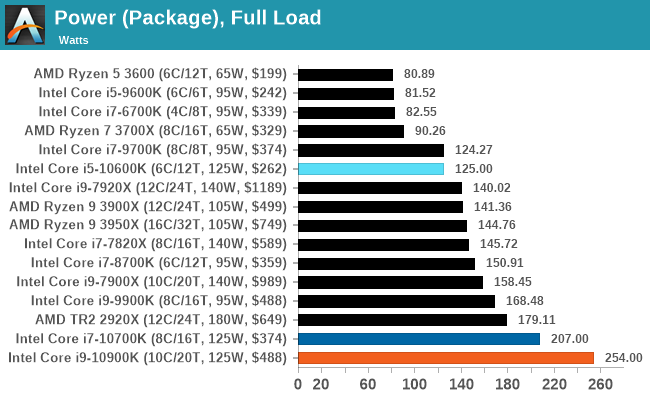
Note, 254 W is quite a lot, and we get 10 cores at 4.9 GHz out of it. By comparison, AMD's 3990X gives 64 cores at 3.2 GHz for 280 W, which goes to show the trade-offs between going wide and going deep. Which one would you rather have?



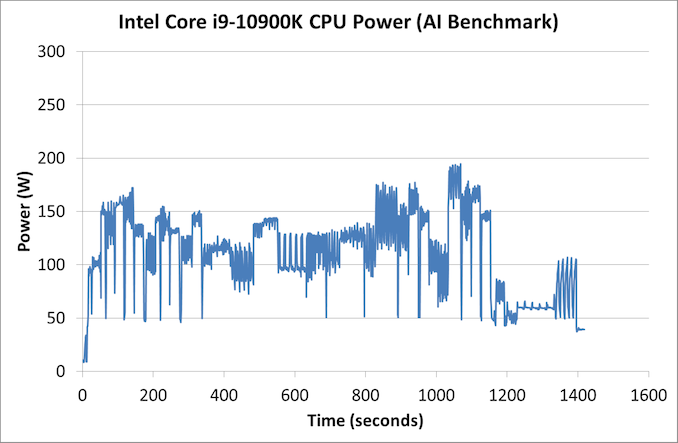
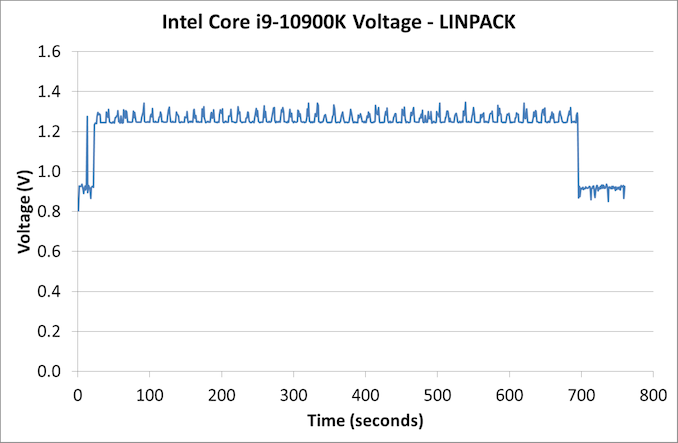
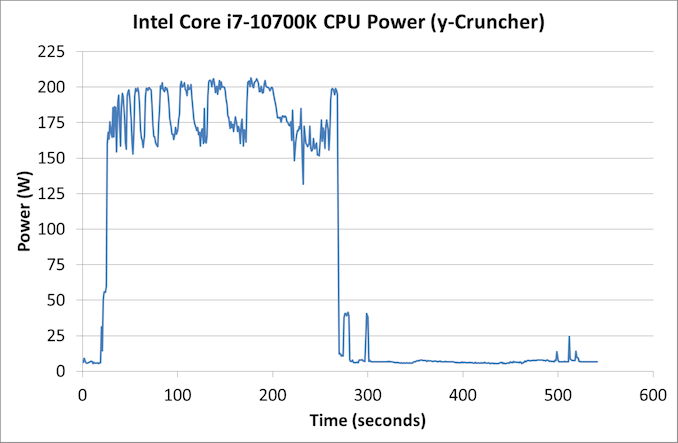
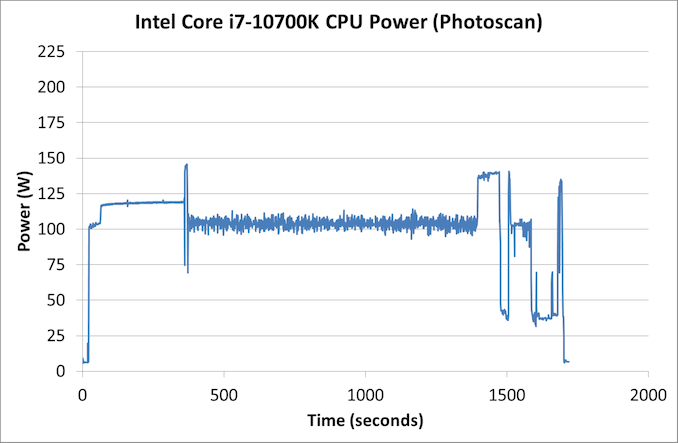
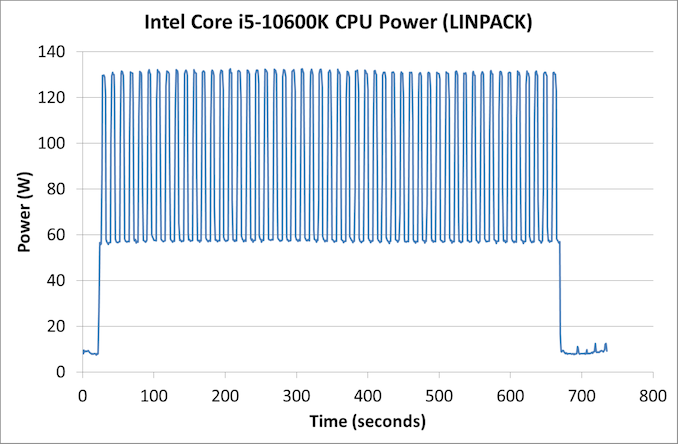
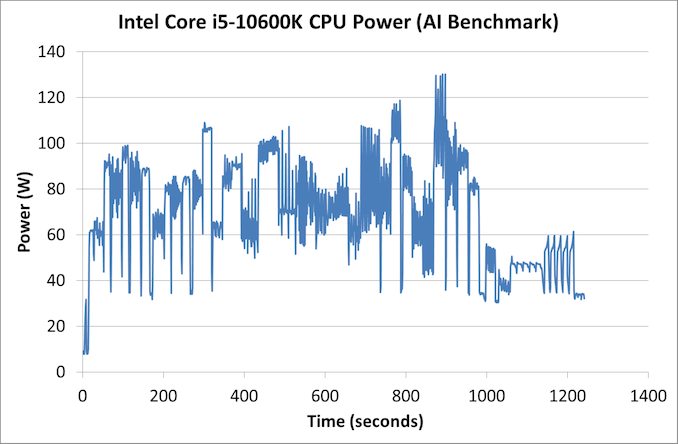














220 Comments
View All Comments
arashi - Sunday, May 24, 2020 - link
Replacing Stewart with xx does not a clone account make.Try again.
Spunjji - Tuesday, May 26, 2020 - link
Good catch XDSpunjji - Tuesday, May 26, 2020 - link
You're talking past yourself.Sure, it's impressive what Intel's disaster management engineers managed to pull out the wreckage of their failure at 10nm. Their failure at 10nm was an engineering failure too, though, and they still haven't managed to backport their 10nm-planned architecture to 14nm.
In other words, those engineering failures are the only reason they had to build this crazy nonsense - of which you express such admiration - in the first place.
extide - Wednesday, May 20, 2020 - link
This is not HEDTSpunjji - Tuesday, May 26, 2020 - link
He's still reading from the 2016 Intel playbook :DIcehawk - Saturday, May 23, 2020 - link
I care because I like silent machines and use fanless PSUs. I can’t afford to blow 250-300W of the power budget on the CPU when I am limited to 450W, the small difference in real world gaming isn’t worth popping for a higher power PSU that brings with it fan noise. I should be able to run my 3900X with a nV 3070 with what I have, I don’t think I could with this i9.If power budget isn’t a concern then it’s down to brand preference, usage mix, etc to me. I have an intel 8700 as well, at the time I felt that was the best CPU choice, when I needed another new machine a few months ago the 3900 was - I still feel it would be today for me.
YMMV
Spunjji - Tuesday, May 26, 2020 - link
Cool, another person who thinks their personal views on a topic outweigh all others and is psychologically projecting that onto the reviewer. This is how 90% of disinformation works now...prophet001 - Wednesday, May 20, 2020 - link
I'm curious as to why this only has 16 pcie lanes into the CPU. How much does running your high performance SSD through the PCH or running your GPU in x8 mode affect performance?GreenReaper - Wednesday, May 20, 2020 - link
Conveniently, there is an article (almost) about that: https://www.anandtech.com/show/15720/intel-ghost-c...azfacea - Wednesday, May 20, 2020 - link
with intel DIY PC marketshare being well below 50% and 10th gen itself having to compete with 9th, 8th, 7th, with supply shortage and everything I doubt these new LGA1200 motherboards can reach 10% of DIY PC which means the" ... 44+ entrants ranging from $150 all the way up to $1200 ..."
are all massive cash burning operations that would never make sense in a million years w/- intel "development funding". they are literally squandering billions of dollars that they took from ripping of the customers. intel is so stupid, gouging its customers like this and then squandering the money for what ?? LGA 1200 has the option to have pcie 4 by the time its irrelevant ? my god WTF is going on there.